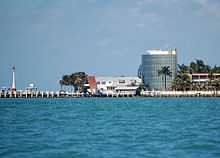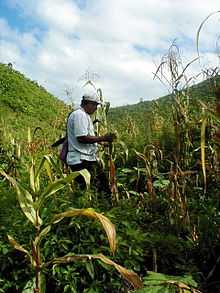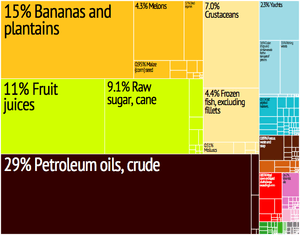Economy of Belize
| Economy of Belize | |
|---|---|
 | |
| Currency | Belize dollar (BZD) |
| 1 April – 31 March | |
Trade organisations | CARICOM, WTO |
| Statistics | |
| GDP |
$1.637 billion (nominal 2013) $3.083 billion (PPP 2013) |
| GDP rank |
165th (nominal 2013 IMF) 166th (PPP 2013 IMF) |
GDP growth | 2.5% (2013 est.) |
GDP per capita | $8,800 (2013 est.) |
GDP by sector | Agriculture (13%), industry (23%), services (64%) (2012 est.) |
| 1.3% (2013 est.) | |
Population below poverty line | 41% (2013 est.) |
Labour force |
139,456 (2012 est.)[1] note: shortage of skilled labor and all types of technical personnel |
Labour force by occupation | Agriculture (10.2%), industry (18.1%), services (71.7%) (2007 est.) |
| Unemployment | 12.1% (2014)[2] |
Main industries | Garment production, food processing, tourism, construction, oil |
| 118th (2015)[3] | |
| External | |
| Exports | $633 million (2013 est.) |
Export goods | Sugar, bananas, citrus, clothing, fish products, molasses, wood, crude oil |
Main export partners |
|
Import goods | Machinery and transport equipment, manufactured goods, fuels, chemicals, pharmaceuticals, food, beverages, tobacco |
Main import partners |
|
Gross external debt | $1.048 billion (December 2013 est.) |
| Public finances | |
| $1.229 billion (2013 est.) | |
| Revenues | $410.1 million (2013 est.) |
| Expenses | $352.4 million (2013 est.) |
|
B- (Domestic) B- (Foreign) B- (T&C Assessment) (Standard & Poor's)[6] | |
Belize has a small, essentially private enterprise economy that is based primarily on agriculture, tourism, and services. The cultivation of newly discovered crude oil in the town of Spanish Lookout has presented new prospects and problems for this developing nation.[7] Besides petroleum, Belize's other primary exports are citrus, sugar, and bananas. Belize's trade deficit has been growing, mostly as a result of low export prices for sugar and bananas. The new government faces important challenges to economic stability. Rapid action to improve tax collection has been promised, but a lack of progress in reining in spending could bring the exchange rate under pressure. The Belize Dollar is fixed to the U.S. dollar at a rate of 2:1.[8]
Domestic industry is limited, constrained by relatively high-cost labour and energy and a small domestic market. Tourism attracts the most foreign direct investment although significant foreign investment is also found in the energy, telecommunications, and agricultural sectors.
History
Belize's economy depended on forestry until well into the 20th century. Logwood, used to make dye, was Belize's initial main export. However, the supply outstripped the demand, especially as Europeans developed man-made dyes which were less expensive. Loggers turned to mahogany, which grew in abundance in the country's forests. The wood was prized for use in cabinets, ships, and railroad carriers. While many merchants and traders became wealthy from the mahogany industry, ups and downs in the market had a large impact on the economy. In addition, new mahogany trees weren't being planted, because mahogany trees grow slowly; the rate of natural regrowth necessitated a large, long-term investment in tree farming, which was not made. As the 19th century progressed, loggers were forced to go deeper into the forests to find the trees, increasing labour costs.
Variations of mahogany exports over long periods of time were linked to the accessible supply of the resource. Thus, improvements in hauling methods helped the cutters satisfy increasing demands for mahogany by enabling them to extract timber from areas in the interior that had been previously inaccessible to them. Immediately after the introduction of cattle in the early 19th century, tractors in the 1920s, and lorries in the 1940s, production levels rose dramatically.
When the supply of accessible timber dwindled and logging became too unprofitable in the 20th century, the country's economy shifted to new sectors. Cane sugar became the principal export and recently has been augmented by expanded production of citrus, bananas, seafood, and apparel. The country has about 8,090 km² of arable land, only a small fraction of which is under cultivation. To curb land speculation, the government enacted legislation in 1973 that requires non-Belizeans to complete a development plan on land they purchase before obtaining title to plots of more than 10 acres (40,000 m²) of rural land or more than one-half acre (2,000 m²) of urban land.
Infrastructure

A major constraint on a functioning market economy in Belize continues to be the scarcity of infrastructure investments. Although electricity, telephone, and water utilities are all relatively good, Belize has the most expensive electricity in the region. Large tracts of land which would be suitable for development are inaccessible due to lack of roads. Some roads, including sections of major highways, are subject to damage or closure during the rainy season. Ports in Belize City, Dangriga, and Big Creek handle regularly scheduled shipping from the U.S. and the United Kingdom although draft is limited to a maximum of 10 feet in Belize City and 15 feet in southern ports. International air service is provided by American Airlines, Continental Airlines, U.S. Airways, and TACA to gateways in Dallas, Texas, Houston, Texas, Charlotte, North Carolina, Miami, Florida, and San Salvador.
Several capital projects are currently underway. The largest of these is a $15 million rural electrification program to be jointly implemented by the government and Belize Electricity Limited (BEL). In addition, the government will continue to implement an Inter-American Development Bank Emergency Reconstruction Fund of $20 million aimed at restoring essential services such as health and education facilities and transportation networks to communities which were severely damaged by Hurricane Keith. The government will also invest close to $4.2 million in projects targeted at poverty alleviation across Belize.
Initiated in 1999, the Ministry of Agriculture and Fisheries, through the Belize Agricultural Health Authority, will continue to implement the IDB-funded "Modernization of Agricultural Health Project." This $2.5 million project seeks to improve the competitiveness of Belize's agricultural products and thus enhance the ability of Belizean farmers and processors to maintain and expand the sale of their high-quality products to foreign markets. A $5 million soybean project, funded by the Brazilian Government, began in 2001 to assist northern Belizean farmers in diversifying away from sugarcane cultivation.
The government also plans to invest $9.85 million to complete the rehabilitation of the Hummingbird Highway, as well as investing $9.5 million in its health-sector reform program. The Ministry of Tourism is confident that another IDB-funded project, the "Tourism Development Project", will make Belize the Mundo Maya centerpiece for travelers to Central America. The government will spend close to $1.4 million in improving access to the Maya archaeological sites in Belize, especially Caracol. Using a soft loan from the Republic of China, the government is funneling $50 million toward the construction of low-cost housing.
Trade

Belize's economic performance is highly susceptible to external market changes. Although moderate growth has been achieved in recent years, the achievements are vulnerable to world commodity price fluctuations and continuation of preferential trading agreements, especially with the U.S. (cane sugar) and UK (bananas).
Belize continues to rely heavily on foreign trade with the United States as its number one trading partner. Total imports in 2000 totaled $446 million while total exports were only $349.9 million. In 2000, the U.S. accounted for 48.5% of Belize's total exports and provided 49.7% of all Belizean imports. Other major trading partners include the European Union, Canada, Mexico, and Caribbean Community (CARICOM) member states. Belize established a preferential trade agreement with Guatemala in 2010.
Belize aims to stimulate the growth of commercial agriculture through CARICOM. However, Belizean trade with the rest of the Caribbean is small compared to that with the United States and Europe. The country is a beneficiary of the Caribbean Basin Initiative (CBI), a U.S. Government program to stimulate investment in Caribbean nations by providing duty-free access to the U.S. market for most Caribbean products. Significant U.S. private investments in citrus and shrimp farms have been made in Belize under CBI. U.S. trade preferences allowing for duty-free re-import of finished apparel cut from U.S. textiles have significantly expanded the apparel industry. EU and UK preferences also have been vital for the expansion and prosperity of the sugar and banana industries.
Tourism and ecotourism
A combination of factors—climate, the Belize Barrier Reef (longest in the Western Hemisphere), 127 offshore Cayes (islands), excellent fishing, safe waters for boating, scuba diving, and snorkeling, abundant jungle flora and fauna, and numerous Mayan ruins—support the thriving tourism and ecotourism industry. Development costs are high, but the Government of Belize has designated tourism as its second development priority after agriculture.
In 2011, tourist arrivals totaled 888,191 (mostly from the U.S.) and tourist receipts amounted to $260 million.[9] The travel and tourism industry in 2011 directly contributed 350.6 million BZD (176 million USD) to Belize's GDP (12.0% of GDP). This primarily reflects the economic activity directly generated by industries supported by tourists, such as hotels, restaurants, leisure industries, travel agents, airlines and other transportation services. The total contribution to GDP in 2011 (including wider effects from investment, the supply chain, and induced income impacts) was 971.9 million BZD (486 million USD) (33.2% of GDP). Travel and tourism directly generated 14,500 jobs in 2011 (10.9% of total employment) and, including indirect and induced effects, supported 40,000 jobs (30.1% of total employment).[10]
Belize International Business Companies
In 1990, Belize enacted the International Business Companies Act based on the British Virgin Islands model. In ten years, Belize has registered more than 15,000 IBCs. A Belizean IBC is a corporate vehicle for international financial transactions and allows the investor to engage in activities including asset protection, operating bank accounts, brokerage accounts, ship ownership, and commission arrangements.
The IBC legislation was supplemented in 1992 with the enactment of a Trusts Act which provides for both onshore and offshore trusts.[11]
Belize IBCs have the following features:
Progressive legislation
- The IBC Act was introduced in 1990 to implement competitive offshore legislation for Belize IBCs which was subsequently amended to reflect the changes required to provide efficient Belize offshore services.
Efficient incorporation/registration
- Belize incorporation is very efficient under normal circumstances, a Belize IBC can be incorporated in a couple of working days.
Flexibility in company structure
- There is no requirement for a secretary, resident or otherwise
- Only one director or shareholder required for the company formation
- Shareholder(s) and director(s) may be the same person
- The shareholder(s) and director(s) can be a natural person or a corporate body
- There is no requirement for appointing local shareholder(s) and director(s)
Privacy of identity of principals
- The documents for Belize offshore Incorporation do not carry the name or identity of any shareholder or director. The names or identities of these persons do not appear in any public record.
Taxation in Belize
- According to the IBC Act of 1990, offshore companies are exempted from all taxes.[12]
See also
References
- ↑ "Labor Force, Total". The World Bank. Retrieved 29 November 2014.
- ↑ "Unemployment Figure Down Year to Year". 7 News Belize. November 26, 2014. Retrieved 28 November 2014.
- ↑ "Ease of Doing Business in Belize". World Bank. Retrieved 2014-11-28.
- ↑ "Export Partners of Belize". CIA World Factbook. 2012. Retrieved 2013-07-26.
- ↑ "Import Partners of Belize". CIA World Factbook. 2012. Retrieved 2013-07-26.
- ↑ "Sovereigns rating list". Standard & Poor's. Retrieved November 28, 2014.
- ↑ Burnett, John (2006). Maya Homeland. Large Oil Field Is Found in Belize; the Angling Begins, 4 January 2007.
- ↑ Belize dollar
- ↑ "Doing Business in Belize: 2012 Country Commercial Guide for U.S. Companies" (PDF). U.S. Commercial Service, U.S. Department of Commerce. Retrieved 26 November 2012.
- ↑ "BELIZE Travel & Tourism Economic Impact Report 2012" (PDF). World Travel & Tourism Council. Retrieved 2012-11-29.
- ↑ http://www.ifsc.gov.bz/about.html
- ↑ http://www.offshoreprivacy.org/Incorporation.html
- CIA Factbook Belize
- Country Commercial Guides 2001: Western Hemisphere - U.S. Department of State, 2000 July 2000
- Belize Economy from the Caribbean Connect
| ||||||||||||||||||||||||||||||||||||||||
| ||||||